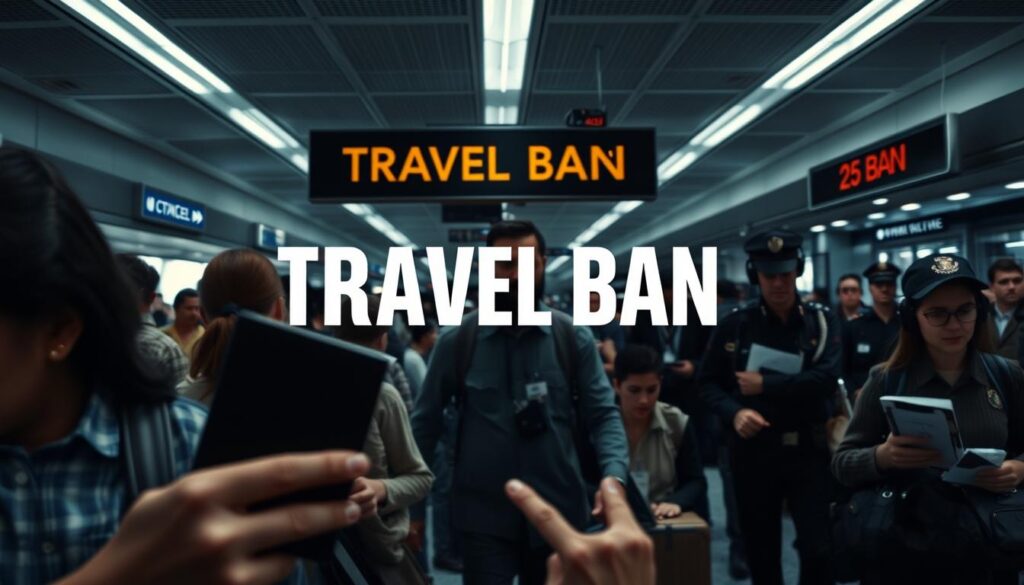Why I Was Banned from This Country
Imagine planning a trip for months, only to find out your destination is suddenly off-limits. That was the reality for millions when a new policy was announced in June 2025.
The United States government introduced a sweeping travel ban affecting citizens from 19 different nations. This decision created immediate uncertainty for students, workers, and families.
If you have connections to any of these countries, you likely felt the impact directly. This guide will help you understand the full scope of the restrictions.
We will explore which nations are affected and what the new rules mean for your future travel plans. You will also learn about potential exceptions and pathways that might still be available.
Introduction and Background
Many people are surprised to learn that similar travel restrictions existed before the recent announcement. Understanding this history helps you grasp why current policies look the way they do.
Context of the New Travel Ban
The current travel ban affects nineteen nations, making it much broader than earlier versions. This expansion represents a significant shift in immigration policy scope.
You might notice the public reaction has been quieter this time. Journalists report that affected communities express more fear than protest energy.
How Policies Have Evolved Over Time
During his first term, President Donald Trump implemented the original trump travel ban. This 2017 policy faced immediate legal challenges and public demonstrations.
The initial ban targeted mostly Muslim-majority nations, earning the “muslim ban” nickname. It went through several revisions before Supreme Court approval in 2018.
| Policy Feature | 2017 Ban | 2025 Ban |
|---|---|---|
| Countries Affected | 8 nations | 19 nations |
| Legal Challenges | Multiple court cases | Fewer immediate challenges |
| Public Response | Major airport protests | Muted community reaction |
| Policy Duration | Active until 2021 | Recently implemented |
President Biden ended the previous travel ban in 2021. The current new travel ban builds on lessons from that earlier time period.
This historical context shows how immigration policy evolves. The current framework incorporates legal precedents from the past.
Understanding the New Travel Ban & Its Direct Effects
Your ability to obtain authorization for U.S. entry has been fundamentally altered by the recent policy changes. The June 2025 restrictions create immediate hurdles for various types of travelers.

Impact on Visa Issuance and Travel
This policy affects both immigrant visas for permanent residency and non-immigrant visas for temporary stays. Tourist, student, and work visas all face new limitations.
Twelve nations face complete restrictions on all visa categories. Seven other locations have partial bans that block immigrant visas but allow some non-immigrant options.
Economic and Social Implications for You
The economic impact is substantial. Recent arrivals from affected nations contributed billions in household income and taxes.
Businesses may experience labor shortages in critical sectors. Families face separation, and international students encounter new barriers to education.
These changes affect community dynamics and economic stability across multiple industries.
Insights on “Banned From This Country” and Related Measures
Legal precedents play a crucial role in understanding why the current restrictions look the way they do. The framework builds directly on past Supreme Court decisions.

This gives the policy a stronger legal foundation than earlier versions.
Comparison with Previous Travel Bans
When you examine the trump travel ban from President Trump’s first term, you notice important differences. The current travel ban affects nearly three times as many nations.
Both policies share similar exemptions for legal permanent residents. However, the 2025 version includes a slower rollout period.
| Aspect | 2018 Ban | 2025 Ban |
|---|---|---|
| Countries Included | 8 nations | 19 nations |
| Legal Precedent | New challenge | Based on upheld Supreme Court ruling |
| Implementation | Rapid rollout | Phased approach |
Legal Justifications and Emerging Controversies
The administration cites three main reasons for this ban. These include inadequate vetting procedures and high visa overstay rates.
Another justification involves nations refusing to accept deported citizens. The Supreme Court upheld a similar travel ban in 2018.
This precedent makes legal challenges more difficult. Yet immigration experts question whether the reasons match the restrictions.
For example, banning immigrant visas based on non-immigrant overstays seems inconsistent. These controversies will likely shape future legal battles.
Political and Community Reactions
The global response to the expanded restrictions highlighted deep divisions. Reactions from affected nations varied dramatically, from diplomatic engagement to direct retaliation.
This created a complex international situation. The government faced criticism and support from many sides.
Media Coverage and Public Perception
News outlets reported on the immediate fallout. For example, Chad suspended visas for US citizens in a swift retaliatory move.
In contrast, Somalia promised to collaborate on security issues. The African Union urged constructive dialogue with all concerned countries.
Within the United States, political figures were split. Congresswoman Pramila Jayapal warned the policy would isolate the nation on the world stage.
Meanwhile, Congressman Clay Higgins stated that travel to the U.S. is a privilege. This debate played out across media platforms.
Perspectives from Affected Communities
For people directly impacted, the human cost is immense. Many citizens from listed nations feel a profound sense of uncertainty.
Human rights activist Guerline Jozef shared that legally residing people fear traveling with passports from their home nations. They worry they might not be allowed back.
This anxiety resonates with many Americans. At a vigil, retiree Kathy Breen expressed desperation, noting the nation “makes refugees, but we don’t take them.”
The overall response has been more muted than in 2017. Many people are simply overwhelmed by the scale of the new travel ban.
Analysis of Affected Countries and Visa Data
Statistical data reveals the human scale behind the travel restrictions implemented last year. The policy creates two distinct categories affecting millions of people worldwide.
Knowing which category applies to you helps determine your options under the current rules.
Full Vs. Partial Ban: Who’s Affected?
Twelve nations face complete restrictions on all visa types. These include Afghanistan, Myanmar, Chad, Congo-Brazzaville, Equatorial Guinea, Eritrea, Haiti, Iran, Libya, Somalia, Sudan, and Yemen.
If you’re from any of these affected countries, you cannot obtain any visas for entry into the United States. The policy blocks both immigrant and non-immigrant pathways.
Seven additional countries operate under partial travel restrictions. This group includes Burundi, Cuba, Laos, Sierra Leone, Togo, Turkmenistan, and Venezuela.
If you’re from one of these seven countries, you might still qualify for certain non-immigrant visas. However, all immigrant visas leading to permanent residency remain blocked.
Statistical Trends in Immigrant and Non-Immigrant Visas
The number people impacted is substantial. These nineteen countries were home to approximately 429.6 million citizens countries in 2023.
In fiscal year 2024, the U.S. issued 161,987 visas that would now be restricted under the June 2025 order. This included 25,086 immigrant visas and 136,901 non-immigrant visas.
About 51% of the affected immigrant visas were family-based categories. This means over 12,000 people who reunited with relatives in June 2025 would now be blocked.
The data shows the real impact on people affected by these changes. Even temporary visits for tourism or business have become impossible for many.
Examining Exceptions, Loopholes, and Future Outlook
Understanding available exemptions is crucial for determining whether the ban actually applies to your situation. The policy includes specific categories that remain eligible for entry despite the broad restrictions.
Exemptions Available for Travelers Like You
Several key groups are exempt from the June 2025 restrictions. If you hold a valid visa or are a lawful permanent resident, you can still travel to the United States.
Your immediate family members who are spouses, parents, or minor children of U.S. citizens also qualify for exemption. Dual nationals using a passport from a non-listed nation can bypass the restrictions entirely.
Special immigrant visa holders, particularly Afghan allies, maintain their eligibility. The Secretary of State may grant case-by-case waivers for national interest reasons.
| Exemption Category | Who Qualifies | Documentation Required |
|---|---|---|
| Lawful Permanent Residents | Green card holders | Valid permanent resident card |
| Family Members | Spouses, parents, minor children of U.S. citizens | Relationship proof, citizenship documents |
| Dual Nationals | Citizens using non-banned country passport | Valid passport from exempt nation |
| Special Cases | Athletes, refugees, national interest cases | Event invitations, refugee status, waiver approval |
Potential Future Adjustments to the Travel Ban
The current list of affected nations might change over time. Starting September 2, 2025, the Secretary of State can recommend adjustments every 180 days.
Countries could be removed if they demonstrate “material improvements” in areas of concern. However, media reports indicate the administration is considering adding 36 more nations to the restricted list.
This potential expansion would primarily affect sub-Saharan African countries. The future effect of these changes could impact over one billion additional people worldwide.
Conclusion
The economic impact of the June 2025 travel ban extends far beyond simple immigration numbers. When nearly 300,000 people from affected countries can no longer enter the United States, the nation loses billions in economic contributions.
For millions of citizens from these nations, the personal consequences are devastating. Families face permanent separation while educational and career opportunities disappear.
The government cites security concerns, but experts question the policy’s consistency. This travel ban may expand to include 36 more countries, affecting over one billion additional people worldwide.
Stay informed about potential changes and understand available exemptions. Connect with immigration advocates if you need help navigating these complex restrictions affecting so many lives.

